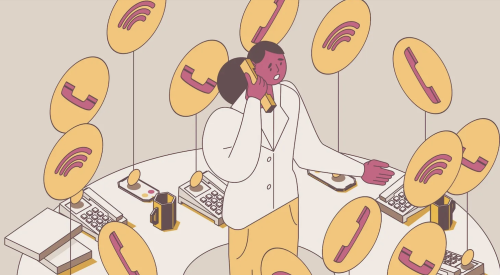For home builders, customers first become customers when they become leads—not when they visit our communities, but when they call us or fill out the contact form.
By then, they have taken time to peruse the builder's website, gather information, and look at available inventory and site plans. The clock starts ticking when the customer dials the “Ask Me for Fast Answers” number or fills out the “Schedule a Visit” form and the expectation of customer service begins.
The online sales specialist’s phone rings or email dings with a new lead. They race to answer or respond by calling or sending an email from their CRM system. They can’t wait to connect and help that excited customer find the home of their dreams! Once the online sales specialist has made the connection with the customer and has built rapport, they spend time qualifying them, and then the sales specialist asks for an appointment. They seamlessly hand off the customer to their on-site sales exec who immediately reaches out and preps for the prospect's upcoming in-person visit.
Oh wait ... I'm dreaming. That was soooo 2020!
RELATED
- Seeing the Future of Online Sales
- Building a Best-Ever Online Sales Team
- Hiring an Online Sales Specialist
Reality Check: A List for Managing Leads in 2021
Here’s your 2021 reality check for managing leads ... er, customers.
Reality Check #1: Home availability
There may not be any inventory homes or home sites available, but homebuyer calls and internet inquiries are still coming in. In fact, they haven’t slowed down. Multiple waitlists have been created for online and on-site. New phases are coming in the future, but dates may be unknown.
Solution: Manage your messaging
- Make sure your website reflects current availability at each community and the protocol for priority interest lists.
- Consider redirecting calls for sold-out communities to a call flow with a voicemail that mimics the messaging on your website. No need for an overwhelmed online sales specialist to take calls for a sold-out community.
- Internal communication between online and on-site is key. Working from one interest list is preferred.
Reality Check #2: Lead volume
Online sales specialists probably aren’t able to provide “fast answers” right now, and they may not be scheduling visits due to sold-out communities or sales caps. With a shift from on-site to online, the increase in leads has naturally caused a delay in response time from online sales. Online sales specialists should be managing no more than 150 to 200 leads per month and should not be setting more than 100 appointments a month on a consistent basis. This scenario is nearly impossible to manage properly.
Solution: Quality over quantity
- Evaluate lead counts and sources. Keep the highest-converting sources and consider pausing others.
- Work backward from the sales goals. Right-size lead volume based on how many sales you need.
- Adjust messaging and reduce calls to action on the website. Consider removing “Fast Answers” and temporarily removing “live” chat features.
- Staff up. Hire more online sales specialists to meet the increase in lead volume or temporarily move over a sales assistant to help with overflow.
- Remember, more leads (customers) poorly managed does not equal more sales.
Reality Check #3: Buyer stress
Our customers aren’t excited; they are most likely anxious and desperate. It used to be that the online home search was like the newly engaged phase where the home shopper’s mind was full of possibilities. We are now talking with home shoppers who are stressed. Nothing is available. They are getting outbid. They have already sold their home. They visit a website that has six “call me for info” calls to action, but they can’t get anyone to answer the phone or respond.
Solution: Authentic transparency
- Authenticity starts on your website with up-to-date information. For example, consider putting, “As of May 1st, Happy Acres is currently sold out. We are anticipating new home sites available in the Fall of 2021. Here are the next steps …”
- Give Online Sales some dialogue options. They need to know what the plan is for each community and for priority interest lists and they need to be able to explain the process to the customer.
- Consider updating auto responders with up-to-date protocols to set expectations from the beginning when a new lead is submitted.
- Have next steps in place for customers who need to get prequalified or find their land for on-your-lot scenarios.
- Refresh follow-up templates to reflect new expectations. If there’s no new information to pass along, replace any language that says, “Contact me now for more information” with “When I know, you’ll know.”
RELATED
- Self-Service and the Homebuying Experience of the Future
- How Good Is Your Online Lead Follow-Up—Even in a Crisis?
Reality Check #4: Additional responsibilities
Online Sales isn’t doing a lot of asking for appointments right now; they're setting appointments. They have become educators, the disappointment police, and masters of presale interest lists. Ultimately, they have become air traffic controllers.
In my mind, air traffic controllers are the ultimate task switchers. They are responsible for keeping everyone happy—the pilots, the airmen on the ground, and the passengers. They have to ensure safety by clearing the way for landing, but sometimes they pacify by keeping the plane circling overhead while the pilot waits for permission to land.
Online sales specialists are sometimes able to land the plane and set appointments, but they also have to keep customers happy while they’re circling and unable to land on a new home at that time.
Solution: Redefine the role of the online sales specialist
- Reevaluate lead-to-appointment and appointment-to-sale goals. Standard conversion metrics may not make sense if appointments and sales are paused.
- Look for new ways this role provides value. Managing the interest lists and educating customers are big ones.
- Refresh follow-up processes. Automate where it makes sense and save personalization for responsive leads that are appropriately qualified.
- Focus on the basics. Brush up on phone skills, follow-up processes, and resources.
- Recognize burnout and come up with a plan of support—whether it’s redirecting or pausing certain leads or increasing staffing.
These current realities can be successfully navigated if you keep the core fundamentals at the forefront. Always remember that your customers’ experience with you is the priority. You can’t control what’s currently going on in their world (or yours for that matter), but you can control how you respond and set expectations from the beginning of their journey with you.
Ultimately, you are there to provide a path to homeownership in the easiest, most pleasant way possible … even if that path is longer than—and different from—what it was in the not-so-distant past.













